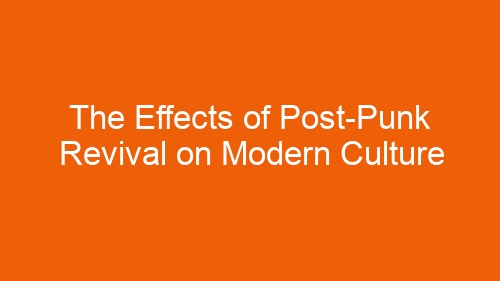-
Table of Contents
Influence of Post-Punk Revival on Fashion Trends
Post-punk revival, a musical movement that emerged in the early 2000s, has had a significant impact on modern culture. One area where this influence is particularly evident is in the world of fashion. The post-punk revival movement drew inspiration from the original post-punk era of the late 1970s and early 1980s, which was characterized by a DIY ethos, a rejection of mainstream norms, and a focus on individuality and self-expression. These same principles have been reflected in the fashion trends that have emerged in the wake of the post-punk revival.
One of the key elements of post-punk fashion is its emphasis on individuality and self-expression. Post-punk musicians and fans often eschew mainstream trends in favor of creating their own unique looks. This rejection of conformity has led to a resurgence of interest in vintage clothing and DIY fashion. Many post-punk enthusiasts take pride in creating their own clothing and accessories, often using recycled materials or repurposing old garments to create new and original pieces.
Another hallmark of post-punk fashion is its embrace of androgyny and gender fluidity. Post-punk musicians and fans often blur traditional gender boundaries through their clothing choices, incorporating elements of both masculine and feminine styles into their looks. This rejection of traditional gender norms has had a ripple effect on mainstream fashion, with many designers and brands now offering gender-neutral clothing lines that cater to a more diverse range of identities.
The post-punk revival movement has also had a significant impact on the color palette and aesthetic of modern fashion. Post-punk fashion is known for its dark, moody color schemes, with black, grey, and other muted tones dominating many post-punk looks. This aesthetic has influenced mainstream fashion trends, with many designers incorporating darker colors and edgier styles into their collections. The influence of post-punk fashion can be seen in everything from streetwear to high fashion, with many designers drawing inspiration from the DIY ethos and rebellious spirit of the post-punk movement.
In addition to its impact on individual style, post-punk fashion has also influenced the way that fashion is marketed and consumed. The rise of social media and online platforms has allowed post-punk enthusiasts to connect with like-minded individuals from around the world, sharing inspiration and ideas for creating their own unique looks. This sense of community and collaboration has led to a more inclusive and diverse fashion landscape, with many brands and designers embracing the DIY ethos of the post-punk movement and offering customizable and personalized clothing options.
Overall, the effects of post-punk revival on modern culture are undeniable, and nowhere is this influence more apparent than in the world of fashion. The DIY ethos, rejection of mainstream norms, and emphasis on individuality and self-expression that are central to post-punk fashion have had a lasting impact on the way that we dress and express ourselves. As we continue to navigate the ever-changing landscape of fashion, it is clear that the legacy of post-punk revival will continue to shape and inspire new trends and styles for years to come.
Impact of Post-Punk Revival on Music and Art
The post-punk revival of the early 2000s had a significant impact on modern culture, particularly in the realms of music and art. This revival saw a resurgence of the raw, edgy sound and aesthetic of the original post-punk movement of the late 1970s and early 1980s. Bands like Interpol, The Strokes, and Yeah Yeah Yeahs drew inspiration from the likes of Joy Division, The Cure, and Siouxsie and the Banshees, creating a new wave of music that combined elements of punk, new wave, and alternative rock.
One of the key effects of the post-punk revival on modern culture was the revitalization of the indie music scene. These bands gained popularity through word of mouth and grassroots promotion, eschewing the traditional music industry model in favor of a DIY approach. This DIY ethos not only influenced the way music was made and distributed but also had a ripple effect on the art world.
The post-punk revival also had a significant impact on the visual arts. The dark, moody aesthetic of bands like Interpol and The Strokes was reflected in the work of contemporary artists who drew inspiration from the music. Artists like Raymond Pettibon and Banks Violette created pieces that captured the gritty, urban feel of post-punk music, using bold lines and stark contrasts to evoke a sense of unease and disquiet.
The influence of the post-punk revival on modern culture can also be seen in fashion. The black leather jackets, skinny jeans, and tousled hair of bands like The Strokes and Yeah Yeah Yeahs became iconic symbols of cool, influencing a generation of young people who sought to emulate their style. This aesthetic was further popularized by fashion designers who incorporated elements of post-punk fashion into their collections, creating a new wave of edgy, street-inspired clothing.
In addition to its impact on music, art, and fashion, the post-punk revival also had a lasting effect on the way we think about culture and society. The music of bands like Interpol and The Strokes often dealt with themes of alienation, disillusionment, and urban decay, reflecting the anxieties of a generation coming of age in a post-9/11 world. This sense of unease and uncertainty permeated not only the music but also the art and fashion that emerged from the post-punk revival.
Overall, the post-punk revival of the early 2000s had a profound impact on modern culture, influencing everything from music and art to fashion and society. Its legacy can still be felt today, as artists and musicians continue to draw inspiration from the raw, edgy sound and aesthetic of the original post-punk movement. As we look back on this period in music history, it is clear that the post-punk revival was not just a fleeting trend but a cultural phenomenon that continues to shape our world in profound ways.
Evolution of Post-Punk Revival in Contemporary Society
Post-punk revival is a genre of music that emerged in the late 1990s and early 2000s, drawing inspiration from the original post-punk movement of the late 1970s and early 1980s. Bands such as Interpol, The Strokes, and Yeah Yeah Yeahs are often credited with popularizing this revival, which has had a significant impact on modern culture.
One of the key characteristics of post-punk revival is its blending of punk rock energy with more melodic and atmospheric elements. This fusion of styles has helped to create a sound that is both familiar and fresh, appealing to a wide range of listeners. The revival has also been characterized by a DIY ethos, with many bands self-releasing their music and building grassroots followings through word-of-mouth and social media.
In addition to its musical influence, post-punk revival has also had a significant impact on fashion and visual arts. The dark, moody aesthetic of bands like Interpol and The Horrors has inspired a resurgence of interest in gothic and punk-inspired fashion, with designers and retailers incorporating elements of the genre into their collections. Similarly, the gritty, urban imagery often associated with post-punk revival has found its way into contemporary art and photography, influencing a new generation of visual artists.
The influence of post-punk revival can also be seen in the realm of film and television. The brooding, introspective themes of many post-punk revival songs have resonated with filmmakers and showrunners, leading to an increase in the use of this music in soundtracks. Bands like The National and Arcade Fire have contributed songs to popular films and TV shows, helping to create a mood that complements the visual storytelling.
Furthermore, the DIY ethos of post-punk revival has inspired a new wave of independent filmmakers and content creators, who are using digital platforms to share their work with a global audience. This democratization of the creative process has allowed for a greater diversity of voices and perspectives to be heard, challenging traditional power structures and opening up new possibilities for artistic expression.
In conclusion, the effects of post-punk revival on modern culture are far-reaching and multifaceted. From its musical innovations to its influence on fashion, visual arts, and film, this genre has left an indelible mark on contemporary society. By blending punk rock energy with melodic and atmospheric elements, post-punk revival has created a sound that is both timeless and relevant, appealing to a new generation of listeners and artists. As we continue to navigate the complexities of the digital age, the DIY ethos of post-punk revival serves as a reminder of the power of creativity and collaboration in shaping our shared cultural landscape.




















